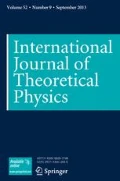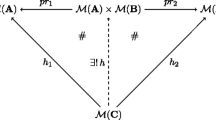Abstract
Categorical approach to probability leads to better understanding of basic notions and constructions in generalized (fuzzy, operational, quantum) probability, where observables—dual notions to generalized random variables (statistical maps)—play a major role. First, to avoid inconsistencies, we introduce three categories \(\mathbb {L}\), \(\mathbb {S}\), and \(\mathbb {P}\), the objects and morphisms of which correspond to basic notions of fuzzy probability theory and operational probability theory, and describe their relationships. To illustrate the advantages of categorical approach, we show that two categorical constructions involving observables (related to the representation of generalized random variables via products, or smearing of sharp observables, respectively) can be described as factorizing a morphism into composition of two morphisms having desired properties. We close with a remark concerning products.







Similar content being viewed by others
References
Adámek, J.: Theory of mathematical structures. Reidel, Dordrecht (1983)
Bugajski, S.: Statistical maps I. Basic properties. Math. Slovaca 51, 321–342 (2001)
Bugajski, S.: Statistical maps II. Operational random variables. Math. Slovaca 51, 343–361 (2001)
Chovanec, F., Kôpka, F.: D-posets. In: Engesser, K., Gabbay, D.M., Lehmann, D. (eds.) Handbook of Quantum Logic and Quantum Structures: Structures, Quantum, pp. 367–428. Elsevier, Amsterdam (2007)
Coecke, B.: Introducing categories to the practicing physicist. In: Sica, G. (ed.) What is Category Theory, pp. 45–74. Polimetrica, Monza (2006)
Dvurecenskij, A.: Smearing of observables and spectral measures on quantum structures. Found. Phys. 43, 210–224 (2012)
Dvurecenskij, A., Pulmannová, S.: New trends in quantum structures. Kluwer Academic Publ. and Ister Science, Dordrecht and Bratislava (2000)
Foulis, J.D.: Algebraic measure theory. Atti Sem. Mat. Fis. Univ. Modena 48, 435–461 (2000)
Fric, R.: Remarks on statistical maps and fuzzy (operational) random variables. Tatra Mt. Math. Publ. 30, 21–34 (2005)
Fric, R.: Extension of domains of states. Soft Comput. 13, 63–70 (2009)
Fric, R.: On D-posets of fuzzy sets. Math. Slovaca 64, 545–554 (2014)
Fric, R.: Statistical maps: a categorical approach. Math. Slovaca 57, 41–57 (2007)
Fric, R., Papčo, M.: On probability domains. Internat. J. Theoret. Phys. 49, 3092–3100 (2010)
Fric, R., Papco, M.: A categorical approach to probability. Stud. Logica 94, 215–230 (2010)
Fric, R., Papco, M.: Fuzzification of crisp domains. Kybernetika 46, 1009–1024 (2010)
Fric, R., Papco, M.: On probability domains II. Internat. J. Theoret. Phys. 50, 3778–3786 (2011)
Fric, R., Papco, M.: On probability domains III. Internat. J. Theoret. Phys. 54, 4237–4246 (2015)
Fric, R., Papco, M.: Upgrading probability via fractions of events. Commun. Math. 24, 29–41 (2016)
Fric, R., Papco, M.: On probability domains IV (Submitted)
Greechie, R.J., Foulis, D.J.: The transition to effect algebras. Internat. J. Theoret. Phys. 34, 1369–1382 (1995)
Gudder, S.: Fuzzy probability theory. Demonstratio Math. 31, 235–254 (1998)
Gudder, S.: Observables and statistical maps. Found. Phys. 29, 877–897 (1999)
Jencová, A., Pulmannová, S., Vinceková, E.: Observables on σ-MV-algebras and σ-lattice effect algebras. Kybernetika 47, 541–559 (2011)
Mesiar, R.: Fuzzy sets and probability theory. Tatra Mt. Math. Publ. 1, 105–123 (1992)
Navara, M.: Probability theory of fuzzy events. In: Montseny, E., Sobrevilla, P. (eds.) Fourth Conference of the European Society for Fuzzy Logic and Technology and 11 Rencontres Francophones sur la Logique Floue et ses Applications, pp. 325–329. Universitat Politecnica de Catalunya, Barcelona, Spain (2005)
Papco, M.: On effect algebras. Soft Comput. 12, 373–379 (2008)
Papco, M.: Fuzzification of probabilistic objects. In: 8th Conference of the European Society for Fuzzy Logic and Technology (EUSFLAT 2013), pp. 67–71 (2013) doi:10.2991/eusat.2013.10
Zadeh, L.A.: Probability measures of fuzzy events. J. Math. Anal. Appl. 23, 421–27 (1968)
Acknowledgements
This work was supported by VEGA 1/0097/16 and VEGA 2/0031/15.
Author information
Authors and Affiliations
Corresponding author
Rights and permissions
About this article
Cite this article
Eliaš, P., Frič, R. Factorization of Observables. Int J Theor Phys 56, 4073–4083 (2017). https://doi.org/10.1007/s10773-017-3436-1
Received:
Accepted:
Published:
Issue Date:
DOI: https://doi.org/10.1007/s10773-017-3436-1




